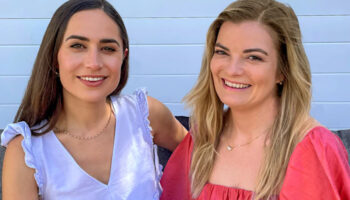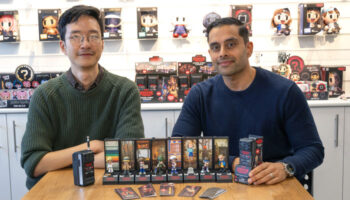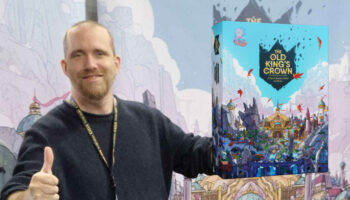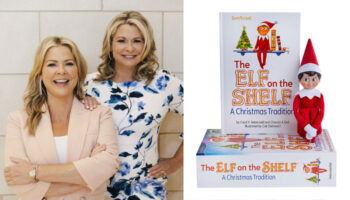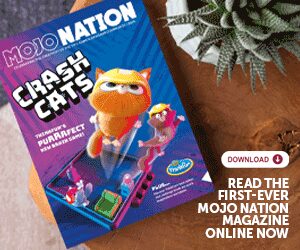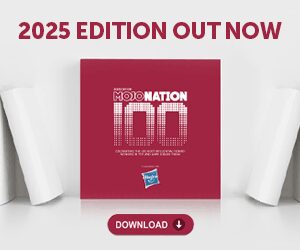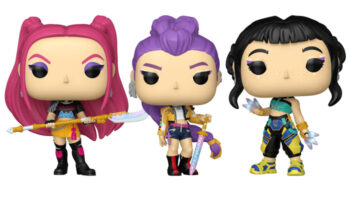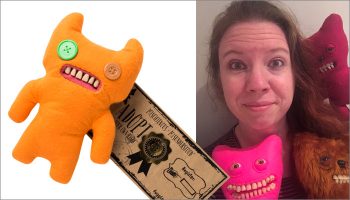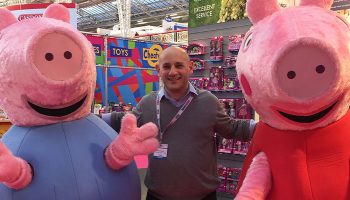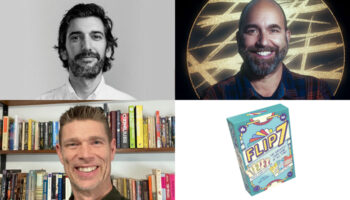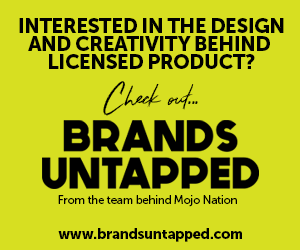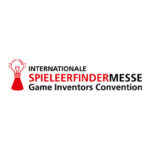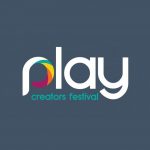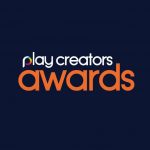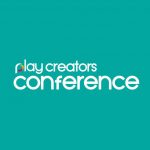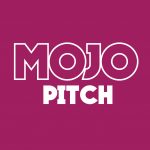Blue Marble’s Lauren Bowers and The Plan A Group’s Lee Allentuck discuss inventor collaborations – and their fun-first approach to STEM toys
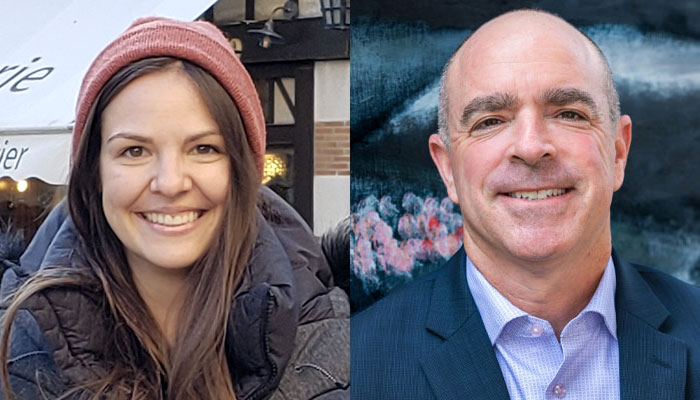
Guys, it’s great to chat. Lauren, this is our first Mojo interview with you, so tell us how you came to be working in this industry?
Lauren Bowers, Director of Product Development, Blue Marble: It came out of left field – I went to school for fashion design and merchandising. When I graduated, it was the recession and I couldn’t find a job anywhere… And I was a terrible at interviews! But I had a friend in the toy industry. She had just gotten a job at CDI, which is now part of Jakks Pacific. They were looking for an Assistant Product Developer. They made Barbie and Disney toys at the time, and it sounded awesome so I managed to convince them to hire me.
In spite of the interview!
Lauren: Yes! I still was bad at my interview! But that set me on this path and here I am now. It’s proven to be a perfect fit.
In what way?
Lauren: Well, I’m a little bit of both right brain and left brain. I love the creative aspect of this industry, but then enjoy keeping everything organized, on time and running smoothly.
And were there many transferrable skills between fashion design and toy development?
Lauren: Absolutely. Being detail oriented and understanding what makes good design. Whether a toy or fashion, it’s important to understand what customers are going to see on the shelf and why it will resonate with them.
Lots of what I do here at Blue Marble are tools I learned in fashion. And a lot of my product development hires have come from many different industries because they bring the same tools but a totally different vision of product development. I love collaborating with people like that and finding new efficiencies from other industries.
Terrific. And for those new to Blue Marble, what recent launches would you point to as great examples of what you focus on?
Lauren: We won a TOTY award for our National Geographic Epic Circuits Science Kit. That’s a great encapsulation of what we do. We specialise in educational STEM toys that provide a meaningful experience for kids. Currently our age range mostly targets kids six and up. As we continue to grow, you’ll see more STEM products for kids 18 months and up including our Blockaroos brand and a line of National Geographic Kids products we just launched this Fall.

Lee, let’s bring you in! Blue Marble is one of your inventor relations clients – how did you come to connect with these guys?
Lee Allentuck, Founder, The Plan A Group: We’ve been working together almost three years now and it started from them simply wanting to tap into new innovations and embrace outside inspiration. They had been doing a little bit of it, but we wanted to create an atmosphere where inventors want to come to us, bring Blue Marble their best ideas and develop relationships over the long-term.
Blue Marble has absolutely been all for meeting people several times to help them best understand what makes something a product for Blue Marble. Lauren, Jordan M. Willing, the owner, and Jared Wolfson, the CEO, have been instrumental in lifting Blue Marble’s credibility and relationships within the inventor community.
That’s what I love helping companies do – build lasting, productive relationships with the inventor community. I’m always excited to collaborate with companies who want to deepen their inventor engagement. That’s where the best ideas come from.
What should inventors be bringing you for Blue Marble?
Lee: We focus heavily on the STEM side of toys, so we’re looking for fun, inspirational experiences that sprinkle in some education. The guys here always say that it really comes down to something being a fun experience first. It’s important to make sure it’s a fun activity that you will play for an hour at least. That’s really what we look for.
And it’s worth mentioning that Blue Marble is an Amazon-first manufacturer. We look for ways to market these products online and that factors into how we evaluate concepts. It’s important to make sure you’re bringing us concepts that we can make, within a reasonable price point and that will really grab attention in-person and online.

So for any inventors out there worried that they might lack the science know-how to invent for Blue Marble…
Lee: I’m not a scientist, and Lauren, last time I checked you’re not a scientist?
Lauren: Good ideas can come from anyone. We have over a decade of experience in this category – inventors can bring us a concept that has commercial potential and let us figure out the science part. So I wouldn’t worry too much about that.
And I would recommend that anybody who really wants to work with us comes to the fireside chat that Jared, myself, and Lee host every Spring. We speak about what makes a great Blue Marble product, as well as what we’re not looking for. We open the curtain and let everybody see some of the secrets of Blue Marble.
How tricky is it to balance fun with education in your products?
Lauren: Well, I have to give a lot of credit to our creative team. They make our products look amazing, dynamic and beautiful. The colours, product, and educational material really pop and that can help set expectations for customers that it’s going to be a fun experience. And we’re constantly evolving to make the way we deliver educational content within our kits, instructions, and learning guides even more engaging. It’s also incredibly important to ensure that as we test products they won’t be thought of as “school after school” and we have a high bar to ensure our products do not fall into that category.
And there’s been an interesting swing at retail on this. There was a time were retailers really valued fun, almost at the expense of STEM. Whereas today, we meet a lot of people who want STEM – education is now attractive to them. I think that’s in part due to teams like our creative team. They’ve changed perceptions around what educational toys should look like.

Absolutely. Now, let’s talk inventors. Can you give us some examples of successful inventor collaborations?
Lauren: Our marble runs are incredibly successful – and the learning aspect there is engineering. You can build it, break it down, build it, break it down – it provides hours of fun. And one of our very first successful inventor products was our line of magnetic marble runs. And in terms of a recent launch, I’d point to the success we’ve had with Fun-Damental Invention and Tie-Dye Dotz. We love working with Gary Pyper and his team.
And Tie-Dye Dotz is essentially a way to tie dye without all the mess.
Lauren: Exactly. You have these little dots of colour – they’re like little teabags with dye inside. You lay them out on your already wet shirt and we give you little droppers so kids can drop water on it to move the ink around. And you can reuse the dot many times. So it’s a lot less mess, a lot more dye.

More dye, less mess. Perfect!
Lauren: We have a big line of products that are more within the art part of STEAM, but we tie them back into science, engineering or math. Tie-Dye Dotz is not only innovative, but something that you can learn from as well.
You mentioned that came from the team at Fun-Damental Invention. What is the key to positive inventor collaborations for you guys?
Lauren: Open communication. We aim to be really clear and thorough with feedback, as well as being transparent around what works for us and what doesn’t. If we don’t believe an item will be successful, we do our best to provide clear and timely feedback on how to modify that item or that it’s not going to work.
Lee: I agree, and it’s a relationship. They take time to build. When we first meet an inventor, it’s a learning experience for both of us, right? The second time we meet, things get a little clearer – concepts are a little more on point because we’re starting to understand what they bring to the table and they’re understanding what we’re looking for. By the third time, we’re usually seeing really solid concepts. And as part of that relationship-building, it’s really important to have trust, as well as what Lauren said about honest and timely feedback
Lauren: Lee does a really great job of cultivating that. Once somebody is an inventor with us, we see them as part of our Blue Marble family.
Lee: We’re smaller than a lot of the bigger companies that do inventor outreach, so we need to build those relationships and prove ourselves a bit. We move fast, make decisions fast and give inventors opportunities that maybe some of the bigger companies can’t or won’t do.
Before we wrap up, what fuels your creativity?
Lauren: I love to look at different industries for inspiration. Pulling from other industries and finding ways to make them work in the toy industry is always fun. And the other thing is my team. My team is incredible, and I find that people fuel my creativity. Two weeks ago I had a developer come into my office and say: “I have no idea what to do with this product”. I said: “Okay, let’s brainstorm.” I didn’t say another word – she immediately responded with: “Well, you know what? I could do this, or this, or this.” It came from us being together – just the act of sitting together and looking at something… That can be enough for crazy ideas to become great products.
Lee: I agree – it’s the conversations. I try to talk to a dozen to 20 people a week, just to talk and hear what’s going on in their world, building on each other’s creative ideas. It’s useful, especially when you’re working alone in a basement! The other thing I do, since I had a health scare two years ago, is to walk every morning. I’ll do anything from three to five miles and it clears my brain. It’s just about staying healthy – and it sets the tone for a creative day.
Guys, it’s been great to catch up. Let’s do it again soon!
–
To stay in the loop with the latest news, interviews and features from the world of toy and game design, sign up to our weekly newsletter here




